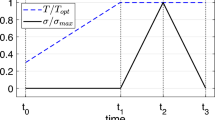Abstract
This paper presents a comparative study between two micro–macro modeling approaches to simulate stress-induced martensitic transformation in shape memory alloys (SMA). One model is a crystal plasticity-based model and the other describes the evolution of the microstructure with a Boltzmann-type statistical approach. Both models consider a self-consistent scheme to perform the scale transition from the local thermomechanical behavior to the global one. The way the two modeling approaches describe the local behavior is analyzed. Similarities and differences are pointed out. Numerical simulations of the thermomechanical behavior of an isotropic titanium-niobium SMA are performed. These alloys have known a growing interest of scientific community given their high potential for application in the biomedical field. Stress–strain curves obtained from the two simulations are compared with experimental results. Evolutions of volume fractions of martensite variants predicted by the two approaches are compared for <100>, <110>, and <111> tensile directions. Due to the absence of comparative studies between multiscale models dedicated for SMA, this paper fills a gap in the state of the art in this field and provides a significant step toward the definition of an efficient numerical tool for the analysis of SMA behavior under multiaxial loadings.








Similar content being viewed by others
Notes
The so-called R-phase of equi-atomic NiTi can be considered in this modeling in addition to martensite and austenite phases.
References
Cisse C, Zaki W, Ben Zineb T (2016) A review of constitutive models and modeling techniques for shape memory alloys. Int J Plast 76:244–284
Mohd Jani J, Leary M, Subic A, Gibson MA (2014) A review of shape memory alloy research, applications and opportunities. Mater Des 56:1078–1113
Auricchio F, Bonetti E, Scalet G, Ubertini F (2014) Theoretical and numerical modeling of shape memory alloys accounting for multiple phase transformations and martensite reorientation. Int J Plast 59:30–54
Chemisky Y, Duval A, Patoor E, Zineb TB (2011) Constitutive model for shape memory alloys including phase transformation, martensitic reorientation and twins accommodation. Mech Mater 43(7):361–376
Lagoudas D, Hartl D, Chemisky Y, Machado L, Popov P (2012) Constitutive model for the numerical analysis of phase transformation in polycrystalline shape memory alloys. Int J Plast 32:155–183
Chemisky Y, Meraghni F, Bourgeois N, Cornell S, Echchorfi R, Patoor E (2015) Analysis of the deformation paths and thermomechanical parameter identification of a shape memory alloy using digital image correlation over heterogeneous tests. Int J Mech Sci 96–97:13–24
Mamivand M, Zaeem MA, ElKadiri H (2013) A review on phase field modeling of martensitic phase transformation. Comput Mater Sci 77:304–311
Lagoudas DC, Entchev PB, Popov P, Patoor E, Brinson C, Xiujie G (2006) Shape memory alloys, Part II: modeling of polycrystals. Mech Mater 38:430–462
Laheurte P, Prima F, Eberhardt A, Gloriant T, Wary M, Patoor E (2010) Mechanical properties of low modulus beta titanium alloys designed from the electronic approach. J Mech Behav Biomed Mater 3:65–573
Miyazaki S, Kim HY, Hosoda H (2006) Development and characterization of Ni-free Ti-base shape memory and superelastic alloys. Mater Sci Eng, A 440:18–24
Sittner P, Heller L, Pilch J, Sedlak P, Frost M, Chemisky Y, Duval A, Piotrowski B, Ben Zineb T, Patoor E, Auricchio F, Morganti S, Reali A, Rio G, Favier D, Liu Y, Gibeau E, Lexcellent C, Boubakar L, Hartl D, Oehler S, Lagoudas DC, Van Humbeeck J (2009) Roundrobin SMA modelling. In: Proceedings of ESOMAT 2009, published by EDP Sciences
Fischlschweiger M, Oberaigner ER (2012) Kinetics and rates of martensitic phase transformation based on statistical physics. Comput Mater Sci 52(1):189–192
Siredey N, Patoor E, Berveiller M, Eberhardt A (1999) Constitutive equations for polycrystalline thermoelastic shape memory alloys: part I. Intragranular interactions and behavior of the grain. Int J Solids Struct 36(28):4289–4315
Maynadier A, Depriester D, Lavernhe-Taillard K, Hubert O (2011) Thermo-mechanical description of phase transformation in Ni-Ti shape memory alloy. Proc Eng 10:2208–2213
McMahon RE, Ji M, Verkhoturov SV, Munoz-Pinto D, Karaman I, Rubitschek F, Maier HJ, Hahn MS (2012) A comparative study of the cytotoxicity and corrosion resistance of nickel-titanium and titanium-niobium shape memory alloys. Acta Biomater 8:2863–2870
Elmay W, Prima F, Gloriant T, Zhong Y, Patoor E, Laheurte P (2013) Effects of thermomechanical process on the microstructure and mechanical properties of a fully martensitic titanium-based biomedical alloy. J Mech Behav Biomed Mater 18:47–56
Hon Y-H, Wang J-Y, Pan Y-N (2003) Composition/phase structure and properties of titanium-niobium alloys. Mater Trans 44(11):2384–2390
Piotrowski B, Ben Zineb T, Patoor E, Eberhardt A (2012) Modeling of niobium precipitates effect on the Ni47 Ti44 Nb9 shape memory alloy behavior. Int J Plast 36:130–147
Fall MD, Hubert O, Mazaleyrat F, Lavernhe-Taillard K, Pasko A (2016) A multiscale modeling of magnetic shape memory alloys: application to Ni 2 MnGa single crystal. IEEE Trans Magn 52:4
Kim HY, Ikehara Y, Kim JI, Hosoda H, Miyazaki S (2006) Martensitic transformation, shape memory effect and superelasticity of Ti-Nb binary alloys. Acta Mater 54:2419–2429
Acknowledgment
The authors gratefully acknowledge the financial support of the Conseil Régional du Grand Est, France.
Author information
Authors and Affiliations
Corresponding author
Additional information
Publisher's Note
Springer Nature remains neutral with regard to jurisdictional claims in published maps and institutional affiliations.
This article is an invited submission to Shape Memory and Superelasticity selected from presentations at the 11th European Symposium on Martensitic Transformations (ESOMAT2018) held August 27–31, 2018 in Metz France and has been expanded from the original presentation.
Rights and permissions
About this article
Cite this article
Fall, M.D., Patoor, E., Hubert, O. et al. Comparative Study of Two Multiscale Thermomechanical Models of Polycrystalline Shape Memory alloys: Application to a Representative volUme Element of Titanium–Niobium. Shap. Mem. Superelasticity 5, 163–171 (2019). https://doi.org/10.1007/s40830-019-00216-7
Published:
Issue Date:
DOI: https://doi.org/10.1007/s40830-019-00216-7




